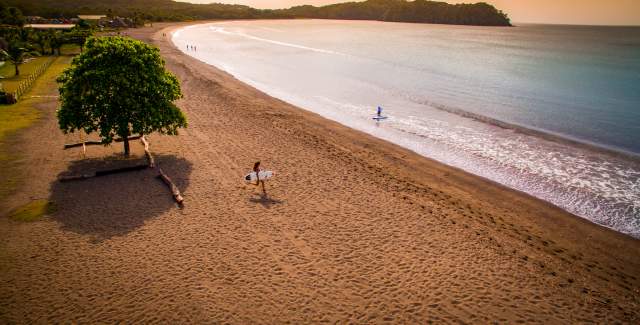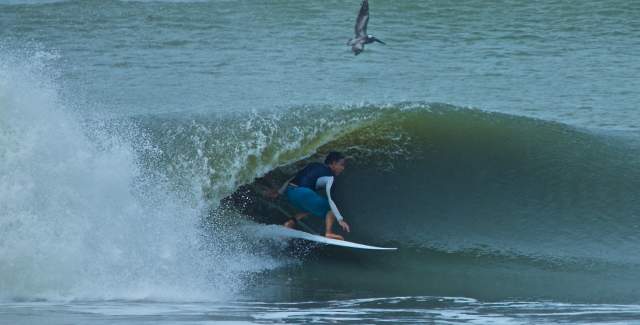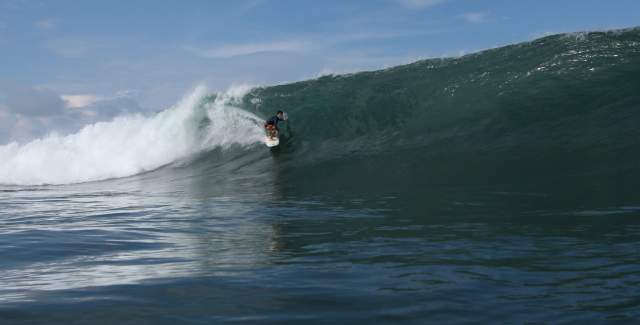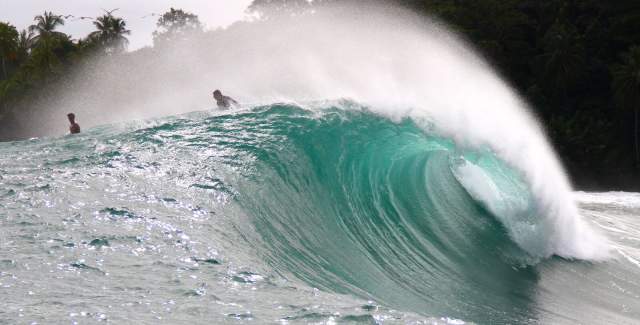Bocas del Toro
Bocas del Toro, in the Panamanian Caribbean, is a globally renowned destination for surfing. Figures...
Your browser is not supported for this experience.
We recommend using Chrome, Firefox, Edge, or Safari.
Panamá is a surfer’s haven. We welcome you to the stunning shores of our fishing villages, vibrant cities, and secluded beach towns. Here, you'll find community, passion, and waves fit for every surfer, no matter the experience level. With more than 1,800 miles of coastline between two bodies of water – the Pacific Ocean and the Caribbean Sea – Panamá is a diverse country with multiple year-round surfing destinations. Here’s your guide to surfing in Panamá.

Considered by many to be one of the most reliable surf spots along the Pacific Coast of Panamá, Santa Catalina in Veraguas Province, has seen a surge of interest over the last decade.
The beach town is located across from Coiba National Park, and it has one of the longest beach breaks in Central America. It also has clear waters and an abundance of exotic marine life, as well as spectacular views. Surfers can catch waves year-round, but for prime swells, we recommend visiting from March through October.
In Santa Catalina, at la Punta, waves can reach 20–30 feet. This is a point break with strong, long waves that break both right and left. The surf is best during medium or high tide. The bottom here is rocky, so we recommend wearing booties. For beginners, there is a sandy beach break close by where the waves break both right and left.
A 30-minute walk northeast of Santa Catalina, visitors can visit Punta Roca, a large point break where the waves can only be ridden during medium or low tide. On the opposite end, a 30-minute walk southeast, Punta Brava boasts left-hand waves that can get twice as big as Santa Catalina.
For an island surf with similar-sized wave breaks, Cebaco Island is accessible by boat. The island has both a beach break and a point break, and its waves break both left and right.
Try Playa Estero if you’re new to the sport since the waves are smaller, plus the area is home to surfing schools if you need a few pointers.

Surfing is also a popular sport in the Pacific Ocean, especially in the Los Santos province.
Playa Venao is a secluded gold sand beach town with boutique hotels and surf lodges. A surprisingly diverse destination for young travelers and surfers of all skill levels, with a global food scene and beach vibe parties.
Set along the Azuero Peninsula's southeast coast in Los Santos, Playa Venao has long been a go-to for surfers. The horseshoe-shaped, brown-sand beach offers long and easy rides. Although it can see good-sized waves, the waves tend to be good for beginner and intermediate surfers. Waves break both right and left and tend to average around 10 feet throughout the year.
About half an hour from Playa Venao, there is Guanico a beach break that has several peaks. Because Guanico is well exposed to any swell direction, waves are usually bigger than Playa Venao.
A one-hour or so car ride away from Playa Venao is another year-round surfing spot – Cambutal in Tonosi, Los Santos, rarely crowded. Once you arrive and have your surfboard in hand, enjoy beach breaks, point breaks, and break surf options. The long stretch of shoreline sees both beach breaks and points, and it tends to catch most swells, so the waves are often a decent size reaching up to 15–20 feet. There’s also a local surf and yoga resort if you’re looking to spend a few days in Cambutal and the Los Santos province.

For those who want to surf in the Pacific Ocean without traveling too far from Panamá City, plan a trip to Riviera Pacifica.
Depending on what beach you visit, the car or bus ride from the capital could take an hour or over two. Check out Chame and Malibu for a beach break with perfect A-frames or El Palmar, some of the more popular surf beaches along the Pacific with long rides and stellar tubes. Playa El Palmar has three breaks (Frente Palmar, Punta Palmar, and Hawaiisito) that offer a varied sampling of waves for every type of surfer. Surfers can expect right-hand and left-hand options and swells from the west, southwest, and south. The waves are best during medium to high tide.
There is a surf school at Playa El Palmar that’s good for beginners. Surfboards can be rented here. Home to top-class golf courses, white-sand beaches, restaurants, and hotels, Riviera Pacifica is where the action is, on and off the water.

Be sure to explore the Gulf of Chiriqui where Morro Negrito is located. This pristine island off the Pacific coast of Panamá in the Chiriqui Province, offers consistent swells. Multiple islands surround Morro.
This pristine island off the Pacific coast of Panamá in Chiriquí offers constant waves. Multiple islands surround Morro Negrito, and each one provides its unique wave, from fast hollow point breaks to sand bottom beach breaks.
Punta Burica is an exposed reef break that has pretty consistent surf, which offers both left and right reef breaks perfect for intermediate and advanced surfers.
Los Olivos is 15 minutes north of downtown Puerto Armuelles. This long stretch of soft sand and palm trees offers a beach break for all surfers.

One of the top surfing destinations in Panamá is the Bocas Del Toro province.
Part mainland and part archipelago, Bocas has over 300 islands and islets in the Caribbean Sea. Three of the islands are prime surfing spots -- Isla Colon, Bastimentos, and Carenero. Start your surfing excursion on Isla Colon, the most populated Bocas Del Toro island, where dozens of restaurants, bars, accommodations, and boat tour companies reside. Isla Colon’s Boca Town is home to the most surf schools and gear rentals in the area, so if you’re a beginner, sign up for a class there.
Paunch, Dumpers, and Bluff are some of the favorite local surf spots with long waves. Paunch Beach is the closest surf spot to Bocas Town and is known for its stellar surf breaks and long waves suitable for all experience levels. Paunch breaks both right and left. When the swell is big, the left side has big, powerful barrels. Playa Paunch is located on the way to the island’s other popular surf spots, Dumpers, and Playa Bluff.
Dumpers is an exposed reef break that has a consistent surf. There is a left-hand reef break, and surfers should watch out for rips, rocks, and reefs. Playa Bluff is a long and beautiful beach at the end of Isla Colon. An exposed, northeast-facing beach break, it boasts powerful, fast-breaking waves only suitable for experienced surfers as it can be a tough feat.
From Bocas Town, hop on a water taxi for a quick seven-minute journey to Bastimentos or a two-minute ride to Carenero, where you can surf some of the top breaks in the area.
In Bastimentos, one of the larger islands featuring the Isla Bastimentos Marine National Park, intermediate surfers won’t want to miss the action at Wizard Beach, a fairly exposed beach and reef break that has fairly consistent surf.
Off Bastimentos, Silverbacks, a 25-minute boat ride from Bocas Town, is one of the area’s most famous and largest surf breaks. Waves may reach up to six meters and can be difficult, making it a spot for professional big-wave riders only.
Carenero is home to several top surf spots, including the one named after the island. The Carenero Point is the longest left-hander that attracts intermediate to advanced surfers. Old Man’s welcomes beginners and intermediate surfers to its calm shores on the Carenero Island and offers left-point surf breaks. It’s the ideal spot to learn how to surf a point break. Off the island is Black Rock, where beginners and intermediate surfers take on right and left breaks along a deep reef.
Bocas del Toro, in the Panamanian Caribbean, is a globally renowned destination for surfing. Figures...
Surfing in Riviera Pacífica is an experience you won't want to miss. Imagine jumping from beach to...
Whether you’re a surfer or not, don't hesitate to swing by the Pacific coast of Veraguas on your...
If you're on vacation in Panamá and you love to brave the waves or you want to learn to surf like...